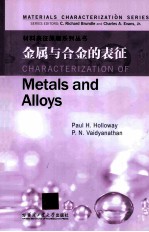图书介绍
金属与合金的表征 英文PDF|Epub|txt|kindle电子书版本网盘下载

- (美)布伦德尔,(美)埃文斯,(美)霍罗威主编 著
- 出版社: 哈尔滨:哈尔滨工业大学出版社
- ISBN:9787560342832
- 出版时间:2014
- 标注页数:309页
- 文件大小:44MB
- 文件页数:328页
- 主题词:金属材料-研究-英文;合金-研究-英文
PDF下载
下载说明
金属与合金的表征 英文PDF格式电子书版下载
下载的文件为RAR压缩包。需要使用解压软件进行解压得到PDF格式图书。建议使用BT下载工具Free Download Manager进行下载,简称FDM(免费,没有广告,支持多平台)。本站资源全部打包为BT种子。所以需要使用专业的BT下载软件进行下载。如BitComet qBittorrent uTorrent等BT下载工具。迅雷目前由于本站不是热门资源。不推荐使用!后期资源热门了。安装了迅雷也可以迅雷进行下载!
(文件页数 要大于 标注页数,上中下等多册电子书除外)
注意:本站所有压缩包均有解压码: 点击下载压缩包解压工具
图书目录
INTRODUCTION1
1.1 Purpose and Organization of the Book1
MECHANICAL PROPERTIES AND INTERFACIAL ANALYSIS4
2.1 Introduction4
2.2 Grain Boundary Segregation6
2.3 Temper Embrittlement8
2.4 Corrosion and Stress Corrosion Cracking12
2.5 Hydrogen Embrittlement17
2.6 Creep Embrittlement19
2.7 Future Directions20
CHEMICAL PROPERTIES24
3.1 Introduction24
3.2 Tools of the Trade—Unique Information Available25
X-ray Photoelectron Spectroscopy(XPS)25
Auger Electron Spectroscopy(AES)29
Secondary Ion Mass Spectrometry(SIMS)31
Rutherford Backscateering Spectroscopy(RBS),Nuclear Reaction Analysis (NRA),and Ion Channeling32
Other Methods32
3.3 Gaseous Corrosion33
High Temperature Corrosion—Influence of Alloy Additions and Coatings34
3.4 Aqueous Corrosion38
Intergranular Stress Corrosion Cracking39
Pit Formation40
3.5 Surface Electronic Structure and Chemistry41
3.6 Surface Modification44
3.7 Summary45
SURFACE AND THIN FILM ANALYSIS OF DIFFUSION IN METALS51
4.1 Introduction51
4.2 The Mathematics of Diffusion52
4.3 Effects of Non-Uniform Cross Sections53
4.4 Effects of Finite Thickness54
4.5 Analysis Techniques for Diffusion56
4.6 Case Studies of Diffusion60
Diffusion in Bulk Samples60
Diffusion in Thin Films64
Analysis of Surface Diffusion71
4.7 Summary71
MINERAL PROCESSING AND METAL RECLAMATION74
5.1 Introduction74
5.2 Techniques for Mineral Surface Characterization75
Direct Analysis of Solid Surfaces of Particles in a Fluid75
Surface Characterization of Mineral Particles Separated from the Processing Fluid78
5.3 Surface Bonding in Mineral-Fluid Systems82
Oxide Mineral Surfaces82
Sulfide Mineral Surfaces83
5.4 Complementary Composition Analyses of Rough and Polished Surfaces85
5.5 Summary88
MELTING AND CASTING92
6.1 Introduction92
6.2 Aluminum-Lithium Alloys94
6.3 Aluminum-Magnesium Alloys97
6.4 Rapidly Solidified Aluminum Alloy Powders100
6.5 Cast Aluminum Alloy Metal Matrix Composites102
6.6 Liquid Aluminum Alloys104
6.7 Summary105
MACHINING AND WORKING OF METALS108
7.1 Introduction108
7.2 Physical and Chemical Characterization109
Physical Properties109
Chemical Properties110
7.3 Lubrication112
7.4 Surface Finish114
7.5 Metalworking Example119
7.6 Summary123
CHARACTERIZATION OF THE CLEANING OF SURFACES OF METALS AND METAL ALLOYS125
8.1 Introduction125
8.2 Characterization of Cleaning Procedures126
Mechanical Cleaning132
Chemical Cleaning133
Cleaning in a Vacuum Chamber136
Detection of Hydrogen and Miscellaneous Cleaning138
8.3 Specimen Handling and Interpretation of Data138
8.4 Summary140
COATINGS AND THIN FILMS144
9.1 Introduction144
9.2 Techniques for Creating Coatings and Thin Films145
Deposition Techniques146
Thick Film Coatings151
Ion Implantation152
Surface Segregation152
Thin Film Structures153
9.3 Techniques to Characterize Coatings and Thin Films153
9.4 Studies of Coatings on Metals155
Polymeric Coatings155
Tribological Coatings160
Passivating Coatings166
Optical and Thermal Coatings168
Electrodeposition170
Surface Modifications by Ion Implantation171
Biocoatings173
9.5 Studies of Thin Films on Metals173
Metal Thin Films174
Semiconductor Thin Films176
Oxide Thin Films177
Ceramic Thin Films179
Carbon-Based Thin Films180
9.6 Summary182
FAILURE ANALYSIS189
10.1 Introduction189
10.2 Collaboration with the Applications Engineering Team191
The Selection of Samples for Analysis192
The Handling and Shipping of Samples193
Providing Sample Background Information194
10.3 Failure Analysis Case Histories195
Metal/Metal Interface and Metal Surface Failures196
Metal/Inorganic Film Failures223
Metal/Polymer Interface Failures232
10.4 Summary240
APPENDIX:TECHNIQUE SUMMARIES247
1 Auger Electron Spectroscopy(AES)247
2 Cathodoluminescence(CL)248
3 Dynamic Secondary Ion Mass Spectrometry(Dynamic SIMS)249
4 Elastic Recoil Spectrometry(ERS)250
5 Electron Energy-Loss Spectroscopy in the Transmission Electron Microscope(EELS)251
6 Electron Probe X-Ray Microanalysis(EPMA)252
7 Energy-Dispersive X-Ray Spectroscopy(EDS)253
8 Extended X-Ray Absorption Fine Structure(EXAFS)254
9 Field Ion Microscopy(FIM)255
10 Fourier Transform Infrared Spectroscopy(FTIR)257
11 Glow-Discharge Mass Spectrometry(GDMS)258
12 High-Resolution Electron Energy Loss Spectroscopy(HREELS)259
13 Inductively Coupled Plasma Mass Spectrometry (ICPMS)260
14 Inductively Coupled Plasma-Optical Emission Spectroscopy(ICP-OES)261
15 Ion Scattering Spectroscopy(ISS)262
16 Laser Ionization Mass Spectrometry(LIMS)263
17 Low-Energy Electron Diffraction(LEED)264
18 Low-Energy Electron Microscopy(LEEM)265
19 Magneto-Optic Kerr Effect(MOKE)267
20 Medium-Energy Ion Scattering with Channeling and Blocking(MEIS)268
21 Neutron Activation Analysis(NAA)269
22 Nuclear Reaction Analysis(NRA)270
23 Optical Micro-Reflectometry(OMR)and Differential Reflectometry(DR)271
24 Optical Second Harmonic Generation(SHG)274
25 Particle-Induced X-Ray Emission(PIXE)276
26 Photoacoustic Spectroscopy(PAS)277
27 Photoelectron Emission Microscopy(PEEM)278
28 Photoluminescence(PL)279
29 Reflected Electron Energy-Loss Spectroscopy(REELS)280
30 Reflection High-Energy Electron Diffraction(RHEED)281
31 Rutherford Backscattering Spectrometry(RBS)282
32 Scanning Electron Microscopy(SEM)283
33 Scanning Transmission Electron Microscopy(STEM)284
34 Scanning Tunneling Microscopy and Scanning Force Microscopy(STM and SFM)285
35 Solid State Nuclear Magnetic Resonance(NMR)286
36 Spark Source Mass Spectrometry(SSMS)287
37 Sputtered Neutral Mass Spectrometry(SNMS)288
38 Static Secondary Ion Mass Spectrometry(Static SIMS)289
39 Surface Analysis by Laser Ionization(SALI)290
40 Surface Extended X-Ray Absorption Fine Structure and Near Edge X-Ray Absorption Fine Structure(SEXAFS/NEXAFS)291
41 Temperature Programmed Desorption(TPD)292
42 Total Reflection X-Ray Fluorescence Analysis(TXRF)295
43 Transmission Electron Microscopy(TEM)296
44 Ultraviolet Photoelectron Spectroscopy(UPS)297
45 Variable-Angle Spectroscopic Ellipsometry(VASE)298
46 X-Ray Diffraction(XRD)299
47 X-Ray Fluorescence(XRF)300
48 X-Ray Photoelectron and Auger Electron Diffraction(XPD and AED)301
49 X-Ray Photoelectron Spectroscopy(XPS)302
Index303